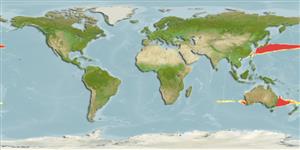>
Aulopiformes (Grinners) >
Scopelarchidae (Pearleyes)
Etymology: Rosenblattichthys: Because of Richard Rosenblatt, ichthyologist os Scripp Institution of Oceanography in La Jolla.
Eponymy: Dr Richard Heinrich ‘Dick’ Rosenblatt (1930–2014) was an American ichthyologist and oceanographer. [...] (Ref. 128868), visit book page.
Environment: milieu / climate zone / depth range / distribution range
Ökologie
seewasser. Temperate
Indo-Pacific: in tropical waters.
Size / Gewicht / Alter
Maturity: Lm ? range ? - ? cm
Max length : 8.0 cm SL Männchen/unbestimmt; (Ref. 41299)
Kurzbeschreibung
Bestimmungsschlüssel | Morphologie | Morphometrie
Rückenflossenstacheln (insgesamt) : 0; Rückenflossenweichstrahlen (insgesamt) : 8 - 9; Afterflossenstacheln: 0; Afterflossenweichstrahlen: 20 - 24; Wirbelzahl: 46 - 47.
Life cycle and mating behavior
Geschlechtsreife | Fortpflanzung | Ablaichen | Eier | Fecundity | Larven
Paxton, J.R., D.F. Hoese, G.R. Allen and J.E. Hanley, 1989. Pisces. Petromyzontidae to Carangidae. Zoological Catalogue of Australia, Vol. 7. Australian Government Publishing Service, Canberra, 665 p. (Ref. 7300)
IUCN Rote Liste Status (Ref. 130435: Version 2024-2)
Bedrohung für Menschen
Harmless
Nutzung durch Menschen
Tools
Zusatzinformationen
Download XML
Internet Quellen
Estimates based on models
Preferred temperature (Ref.
123201): 6.4 - 14.2, mean 10.8 °C (based on 18 cells).
Phylogenetic diversity index (Ref.
82804): PD
50 = 0.5625 [Uniqueness, from 0.5 = low to 2.0 = high].
Bayesian length-weight: a=0.01122 (0.00514 - 0.02450), b=3.04 (2.87 - 3.21), in cm total length, based on all LWR estimates for this body shape (Ref.
93245).
Trophic level (Ref.
69278): 3.9 ±0.7 se; based on size and trophs of closest relatives
Fishing Vulnerability (Ref.
59153): Low vulnerability (10 of 100).
